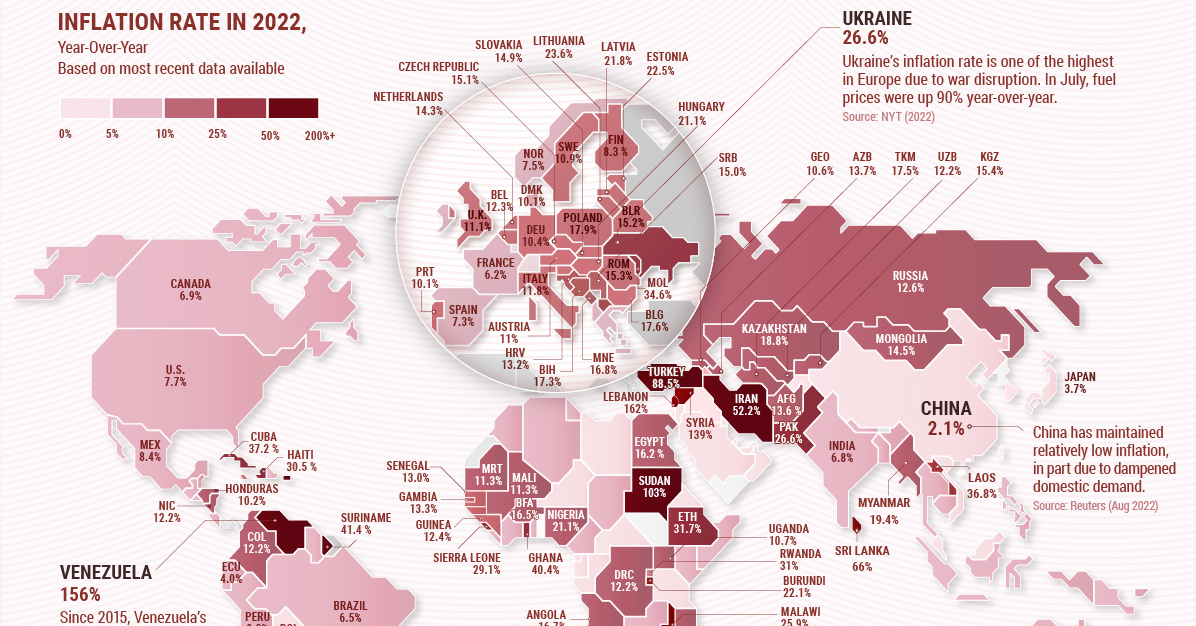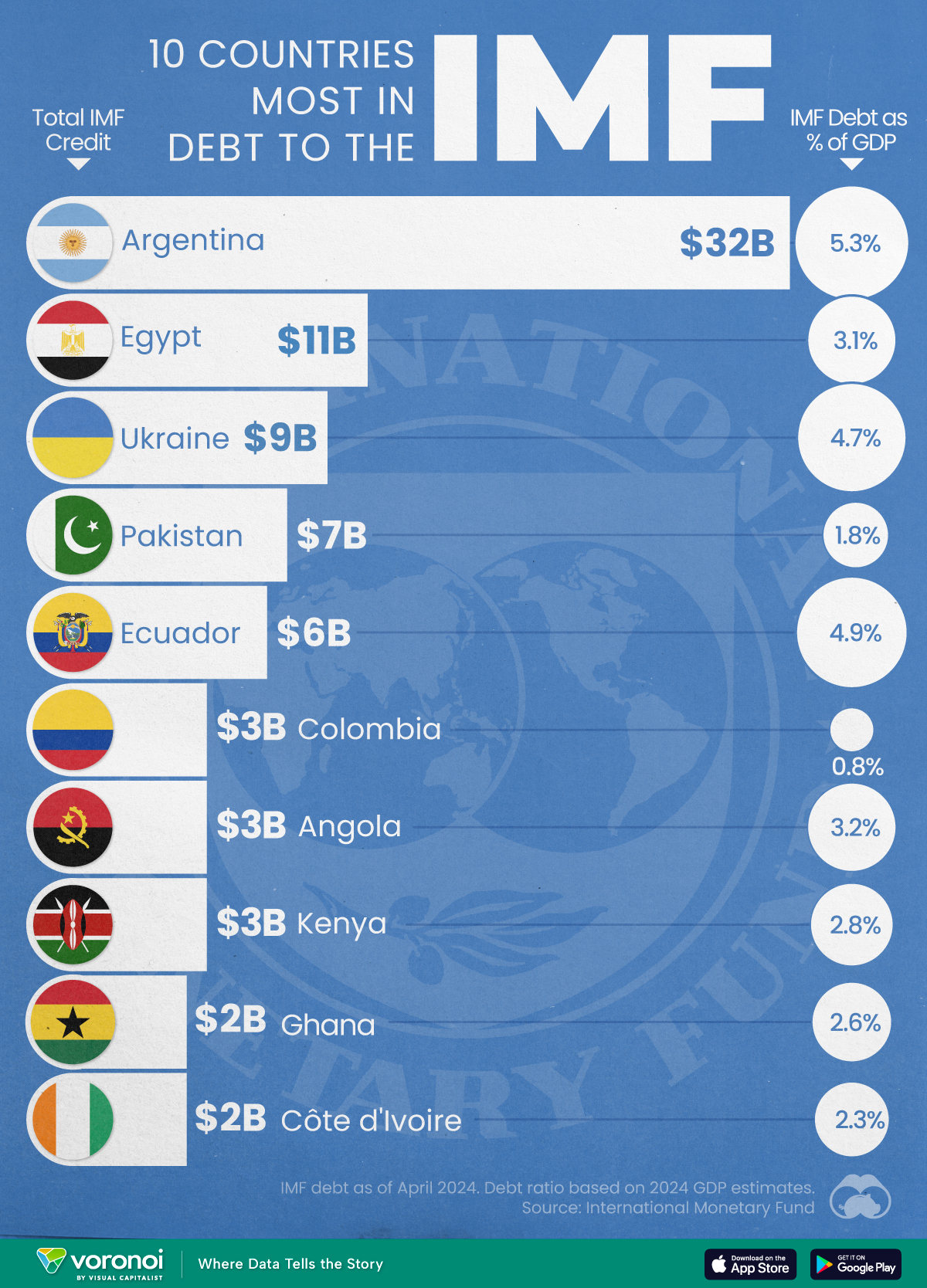Money
Mapped: Which Countries Have the Highest Inflation?
![]() Subscribe to the Elements free mailing list for more like this
Subscribe to the Elements free mailing list for more like this
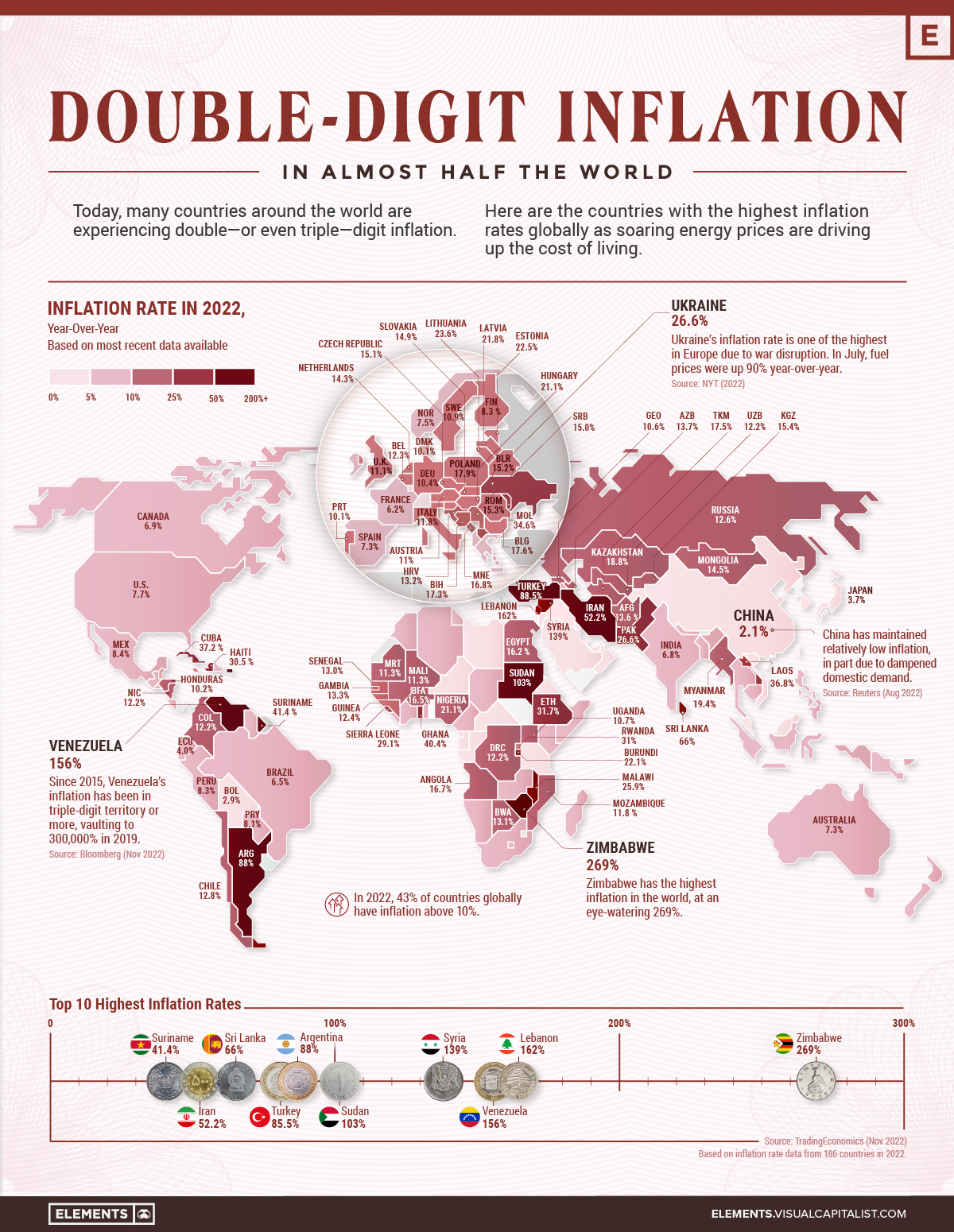
Mapped: Which Countries Have the Highest Inflation Rate?
This was originally posted on Elements. Sign up to the free mailing list to get beautiful visualizations on natural resource megatrends in your email every week.
Inflation is surging nearly everywhere in 2022.
Geopolitical tensions are triggering high energy costs, while supply-side disruptions are also distorting consumer prices. The end result is that almost half of countries worldwide are seeing double-digit inflation rates or higher.
With new macroeconomic forces shaping the global economy, the above infographic shows countries with the highest inflation rates, using data from Trading Economics.
Double-Digit Inflation in 2022
As the table below shows, countless countries are navigating record-high levels of inflation. Some are even facing triple-digit inflation rates. Globally, Zimbabwe, Lebanon, and Venezuela have the highest rates in the world.
| Country | Inflation Rate, Year-Over-Year | Date |
|---|---|---|
| 🇿🇼 Zimbabwe | 269.0% | Oct 2022 |
| 🇱🇧 Lebanon | 162.0% | Sep 2022 |
| 🇻🇪 Venezuela | 156.0% | Oct 2022 |
| 🇸🇾 Syria | 139.0% | Aug 2022 |
| 🇸🇩 Sudan | 103.0% | Oct 2022 |
| 🇦🇷 Argentina | 88.0% | Oct 2022 |
| 🇹🇷 Turkey | 85.5% | Oct 2022 |
| 🇱🇰 Sri Lanka | 66.0% | Oct 2022 |
| 🇮🇷 Iran | 52.2% | Aug 2022 |
| 🇸🇷 Suriname | 41.4% | Sep 2022 |
| 🇬🇭 Ghana | 40.4% | Oct 2022 |
| 🇨🇺 Cuba | 37.2% | Sep 2022 |
| 🇱🇦 Laos | 36.8% | Oct 2022 |
| 🇲🇩 Moldova | 34.6% | Oct 2022 |
| 🇪🇹 Ethiopia | 31.7% | Oct 2022 |
| 🇷🇼 Rwanda | 31.0% | Oct 2022 |
| 🇭🇹 Haiti | 30.5% | Jul 2022 |
| 🇸🇱 Sierra Leone | 29.1% | Sep 2022 |
| 🇵🇰 Pakistan | 26.6% | Oct 2022 |
| 🇺🇦 Ukraine | 26.6% | Oct 2022 |
| 🇲🇼 Malawi | 25.9% | Sep 2022 |
| 🇱🇹 Lithuania | 23.6% | Oct 2022 |
| 🇪🇪 Estonia | 22.5% | Oct 2022 |
| 🇧🇮 Burundi | 22.1% | Oct 2022 |
| 🇸🇹 Sao Tome and Principe | 21.9% | Sep 2022 |
| 🇱🇻 Latvia | 21.8% | Oct 2022 |
| 🇭🇺 Hungary | 21.1% | Oct 2022 |
| 🇳🇬 Nigeria | 21.1% | Oct 2022 |
| 🇲🇰 Macedonia | 19.8% | Oct 2022 |
| 🇲🇲 Myanmar | 19.4% | Jun 2022 |
| 🇰🇿 Kazakhstan | 18.8% | Oct 2022 |
| 🇵🇱 Poland | 17.9% | Oct 2022 |
| 🇧🇬 Bulgaria | 17.6% | Oct 2022 |
| 🇹🇲 Turkmenistan | 17.5% | Dec 2021 |
| 🇧🇦 Bosnia and Herzegovina | 17.3% | Sep 2022 |
| 🇲🇪 Montenegro | 16.8% | Oct 2022 |
| 🇦🇴 Angola | 16.7% | Oct 2022 |
| 🇧🇫 Burkina Faso | 16.5% | Sep 2022 |
| 🇪🇬 Egypt | 16.2% | Oct 2022 |
| 🇰🇲 Comoros | 15.9% | Sep 2022 |
| 🇰🇬 Kyrgyzstan | 15.4% | Oct 2022 |
| 🇷🇴 Romania | 15.3% | Oct 2022 |
| 🇧🇾 Belarus | 15.2% | Oct 2022 |
| 🇨🇿 Czech Republic | 15.1% | Oct 2022 |
| 🇷🇸 Serbia | 15.0% | Oct 2022 |
| 🇸🇰 Slovakia | 14.9% | Oct 2022 |
| 🇲🇳 Mongolia | 14.5% | Oct 2022 |
| 🇳🇱 Netherlands | 14.3% | Oct 2022 |
| 🇦🇿 Azerbaijan | 13.7% | Oct 2022 |
| 🇦🇫 Afghanistan | 13.6% | Sep 2022 |
| 🇬🇲 Gambia | 13.3% | Sep 2022 |
| 🇭🇷 Croatia | 13.2% | Oct 2022 |
| 🇧🇼 Botswana | 13.1% | Oct 2022 |
| 🇸🇳 Senegal | 13.0% | Oct 2022 |
| 🇨🇱 Chile | 12.8% | Oct 2022 |
| 🇽🇰 Kosovo | 12.7% | Oct 2022 |
| 🇷🇺 Russia | 12.6% | Oct 2022 |
| 🇬🇳 Guinea | 12.4% | Jul 2022 |
| 🇧🇪 Belgium | 12.3% | Oct 2022 |
| 🇨🇴 Colombia | 12.2% | Oct 2022 |
| 🇺🇿 Uzbekistan | 12.2% | Oct 2022 |
| 🇨🇬 Congo | 12.2% | Oct 2022 |
| 🇳🇮 Nicaragua | 12.2% | Oct 2022 |
| 🇰🇾 Cayman Islands | 12.1% | Jun 2022 |
| 🇲🇺 Mauritius | 11.9% | Oct 2022 |
| 🇲🇿 Mozambique | 11.8% | Oct 2022 |
| 🇮🇹 Italy | 11.8% | Oct 2022 |
| 🇲🇱 Mali | 11.3% | Sep 2022 |
| 🇲🇷 Mauritania | 11.3% | Sep 2022 |
| 🇬🇧 United Kingdom | 11.1% | Oct 2022 |
| 🇦🇹 Austria | 11.0% | Oct 2022 |
| 🇸🇪 Sweden | 10.9% | Oct 2022 |
| 🇺🇬 Uganda | 10.7% | Oct 2022 |
| 🇬🇪 Georgia | 10.6% | Oct 2022 |
| 🇩🇪 Germany | 10.4% | Oct 2022 |
| 🇭🇳 Honduras | 10.2% | Oct 2022 |
| 🇩🇰 Denmark | 10.1% | Oct 2022 |
| 🇵🇹 Portugal | 10.1% | Oct 2022 |
| 🇯🇲 Jamaica | 9.9% | Oct 2022 |
| 🇸🇮 Slovenia | 9.9% | Oct 2022 |
| 🇬🇹 Guatemala | 9.7% | Oct 2022 |
| 🇿🇲 Zambia | 9.7% | Oct 2022 |
| 🇰🇪 Kenya | 9.6% | Oct 2022 |
| 🇦🇲 Armenia | 9.5% | Oct 2022 |
| 🇮🇸 Iceland | 9.4% | Oct 2022 |
| 🇲🇬 Madagascar | 9.3% | Aug 2022 |
| 🇮🇪 Ireland | 9.2% | Oct 2022 |
| 🇱🇸 Lesotho | 9.2% | Sep 2022 |
| 🇹🇳 Tunisia | 9.2% | Oct 2022 |
| 🇬🇷 Greece | 9.1% | Oct 2022 |
| 🇺🇾 Uruguay | 9.1% | Oct 2022 |
| 🇨🇷 Costa Rica | 9.0% | Oct 2022 |
| 🇧🇩 Bangladesh | 8.9% | Oct 2022 |
| 🇨🇾 Cyprus | 8.8% | Oct 2022 |
| 🇫🇴 Faroe Islands | 8.8% | Sep 2022 |
| 🇩🇿 Algeria | 8.7% | Sep 2022 |
| 🇳🇵 Nepal | 8.6% | Sep 2022 |
| 🇸🇧 Solomon Islands | 8.5% | Aug 2022 |
| 🇲🇽 Mexico | 8.4% | Oct 2022 |
| 🇬🇼 Guinea Bissau | 8.4% | Sep 2022 |
| 🇦🇱 Albania | 8.3% | Oct 2022 |
| 🇧🇧 Barbados | 8.3% | Aug 2022 |
| 🇫🇮 Finland | 8.3% | Oct 2022 |
| 🇲🇦 Morocco | 8.3% | Sep 2022 |
| 🇵🇪 Peru | 8.3% | Oct 2022 |
| 🇩🇴 Dominican Republic | 8.2% | Oct 2022 |
| 🇨🇻 Cape Verde | 8.2% | Oct 2022 |
| 🇵🇾 Paraguay | 8.1% | Oct 2022 |
| 🇹🇱 East Timor | 7.9% | Sep 2022 |
| 🇹🇬 Togo | 7.9% | Sep 2022 |
| 🇵🇭 Philippines | 7.7% | Oct 2022 |
| 🇺🇸 U.S. | 7.7% | Oct 2022 |
| 🇨🇲 Cameroon | 7.6% | Sep 2022 |
| 🇳🇴 Norway | 7.5% | Oct 2022 |
| 🇸🇬 Singapore | 7.5% | Sep 2022 |
| 🇿🇦 South Africa | 7.5% | Sep 2022 |
| 🇸🇻 El Salvador | 7.5% | Oct 2022 |
| 🇲🇹 Malta | 7.4% | Oct 2022 |
| 🇦🇺 Australia | 7.3% | Sep 2022 |
| 🇪🇸 Spain | 7.3% | Oct 2022 |
| 🇹🇩 Chad | 7.2% | Sep 2022 |
| 🇳🇿 New Zealand | 7.2% | Sep 2022 |
| 🇧🇿 Belize | 7.1% | Sep 2022 |
| 🇳🇦 Namibia | 7.1% | Oct 2022 |
| 🇦🇼 Aruba | 7.0% | Sep 2022 |
| 🇨🇦 Canada | 6.9% | Oct 2022 |
| 🇱🇺 Luxembourg | 6.9% | Oct 2022 |
| 🇸🇴 Somalia | 6.9% | Oct 2022 |
| 🇮🇳 India | 6.8% | Oct 2022 |
| 🇦🇪 United Arab Emirates | 6.8% | Jun 2022 |
| 🇬🇾 Guyana | 6.5% | Sep 2022 |
| 🇱🇷 Liberia | 6.5% | Jul 2022 |
| 🇧🇷 Brazil | 6.5% | Oct 2022 |
| 🇧🇸 Bahamas | 6.3% | Aug 2022 |
| 🇨🇮 Ivory Coast | 6.3% | Sep 2022 |
| 🇹🇹 Trinidad and Tobago | 6.3% | Aug 2022 |
| 🇫🇷 France | 6.2% | Oct 2022 |
| 🇩🇯 Djibouti | 6.1% | Sep 2022 |
| 🇵🇷 Puerto Rico | 6.1% | Sep 2022 |
| 🇧🇹 Bhutan | 6.1% | Sep 2022 |
| 🇧🇹 Qatar | 6.0% | Sep 2022 |
| 🇹🇭 Thailand | 6.0% | Oct 2022 |
| 🇸🇿 Swaziland | 5.8% | Aug 2022 |
| 🇮🇩 Indonesia | 5.7% | Oct 2022 |
| 🇰🇷 South Korea | 5.7% | Oct 2022 |
| 🇹🇯 Tajikistan | 5.7% | Sep 2022 |
| 🇵🇬 Papua New Guinea | 5.5% | Jun 2022 |
| 🇰🇭 Cambodia | 5.4% | Jul 2022 |
| 🇮🇶 Iraq | 5.3% | Sep 2022 |
| 🇯🇴 Jordan | 5.2% | Oct 2022 |
| 🇫🇯 Fiji | 5.1% | Sep 2022 |
| 🇮🇱 Israel | 5.1% | Oct 2022 |
| 🇳🇨 New Caledonia | 5.0% | Sep 2022 |
| 🇹🇿 Tanzania | 4.9% | Oct 2022 |
| 🇧🇲 Bermuda | 4.5% | Jul 2022 |
| 🇪🇷 Eritrea | 4.5% | Dec 2021 |
| 🇲🇾 Malaysia | 4.5% | Sep 2022 |
| 🇭🇰 Hong Kong | 4.4% | Sep 2022 |
| 🇵🇸 Palestine | 4.4% | Oct 2022 |
| 🇧🇳 Brunei | 4.3% | Sep 2022 |
| 🇱🇾 Libya | 4.3% | Sep 2022 |
| 🇻🇳 Vietnam | 4.3% | Oct 2022 |
| 🇪🇨 Ecuador | 4.0% | Oct 2022 |
| 🇧🇭 Bahrain | 4.0% | Sep 2022 |
| 🇯🇵 Japan | 3.7% | Oct 2022 |
| 🇰🇼 Kuwait | 3.2% | Sep 2022 |
| 🇳🇪 Niger | 3.2% | Sep 2022 |
| 🇲🇻 Maldives | 3.1% | Sep 2022 |
| 🇬🇦 Gabon | 3.0% | Jul 2022 |
| 🇱🇮 Liechtenstein | 3.0% | Oct 2022 |
| 🇸🇦 Saudi Arabia | 3.0% | Oct 2022 |
| 🇨🇭 Switzerland | 3.0% | Oct 2022 |
| 🇸🇨 Seychelles | 2.9% | Oct 2022 |
| 🇬🇶 Equatorial Guinea | 2.9% | Dec 2021 |
| 🇧🇴 Bolivia | 2.9% | Oct 2022 |
| 🇹🇼 Taiwan | 2.7% | Oct 2022 |
| 🇨🇫 Central African Republic | 2.7% | Dec 2021 |
| 🇻🇺 Vanuatu | 2.7% | Mar 2022 |
| 🇴🇲 Oman | 2.4% | Sep 2022 |
| 🇧🇯 Benin | 2.1% | Oct 2022 |
| 🇨🇳 China | 2.1% | Oct 2022 |
| 🇵🇦 Panama | 1.9% | Sep 2022 |
| 🇲🇴 Macau | 1.1% | Sep 2022 |
| 🇸🇸 South Sudan | -2.5% | Aug 2022 |
*Inflation rates based on the latest available data.
As price pressures mount, 33 central banks tracked by the Bank of International Settlements (out of a total of 38) have raised interest rates this year. These coordinated rate hikes are the largest in two decades, representing an end to an era of rock-bottom interest rates.
Going into 2023, central banks could continue this shift towards hawkish policies as inflation remains aggressively high.
The Role of Energy Prices
Driven by the war in Ukraine, energy inflation is pushing up the cost of living around the world.
Since October 2020, an index of global energy prices—made up of crude oil, natural gas, coal, and propane—has increased drastically.
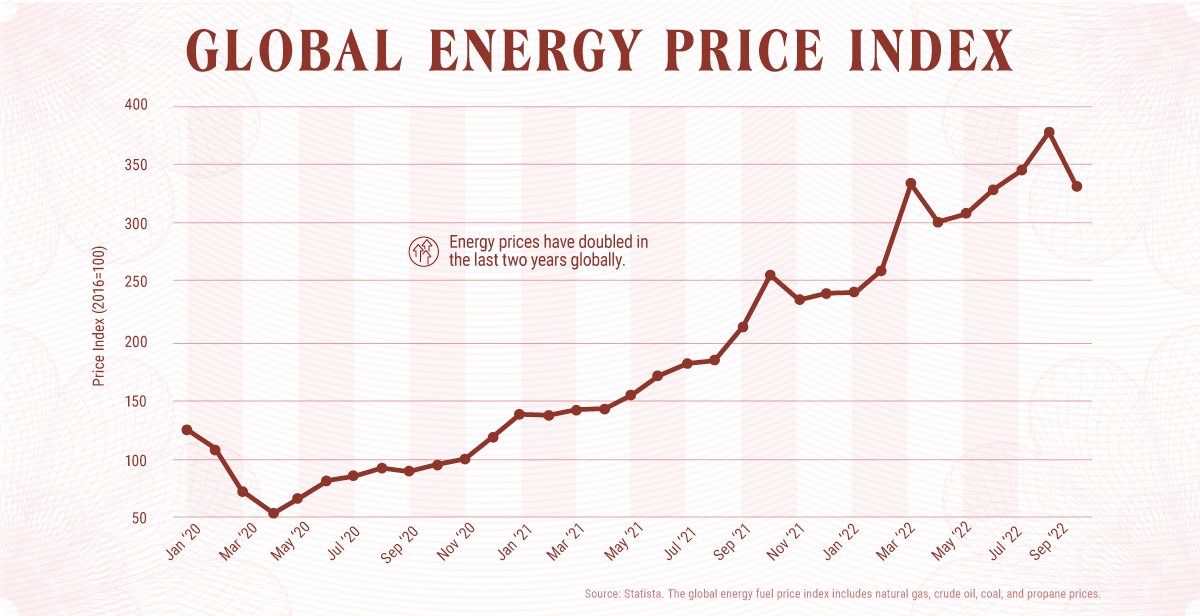
Compared to the 2021 average, natural gas prices in Europe are up sixfold. Real European household electricity prices are up 78% and gas prices have climbed even more, at 144% compared to 20-year averages.
Amid global competition for liquefied natural gas supplies, price pressures are likely to stay high, even though they have fallen recently. Other harmful consequences of the energy shock include price volatility, economic strain, and energy shortages.
“The world is in the midst of the first truly global energy crisis, with impacts that will be felt for years to come”.
-Fatih Birol, executive director of the IEA
Double-Digit Inflation: Will it Last?
If history is an example, taming rising prices could take at least a few years yet.
Take the sky-high inflation of the 1980s. Italy, which managed to combat inflation faster than most countries, brought down inflation from 22% in 1980 to 4% in 1986.
If global inflation rates, which hover around 9.8% in 2022, were to follow this course, it would take at least until 2025 for levels to reach the 2% target.
It’s worth noting that inflation was also highly volatile over this decade. Consider how inflation fell across much of the rich world by 1981 but shot up again in 1987 amid higher energy prices. Federal Reserve chair Jerome Powell spoke to the volatility of inflation at their November meeting, indicating that high inflation has a chance of following a period of low inflation.
While the Federal Reserve projects U.S. inflation to fall closer to its 2% target by 2024, the road ahead could still get a lot bumpier between now and then.
Markets
Top 10 Countries Most in Debt to the IMF
Argentina tops the ranking, with a debt equivalent to 5.3% of the country’s GDP.
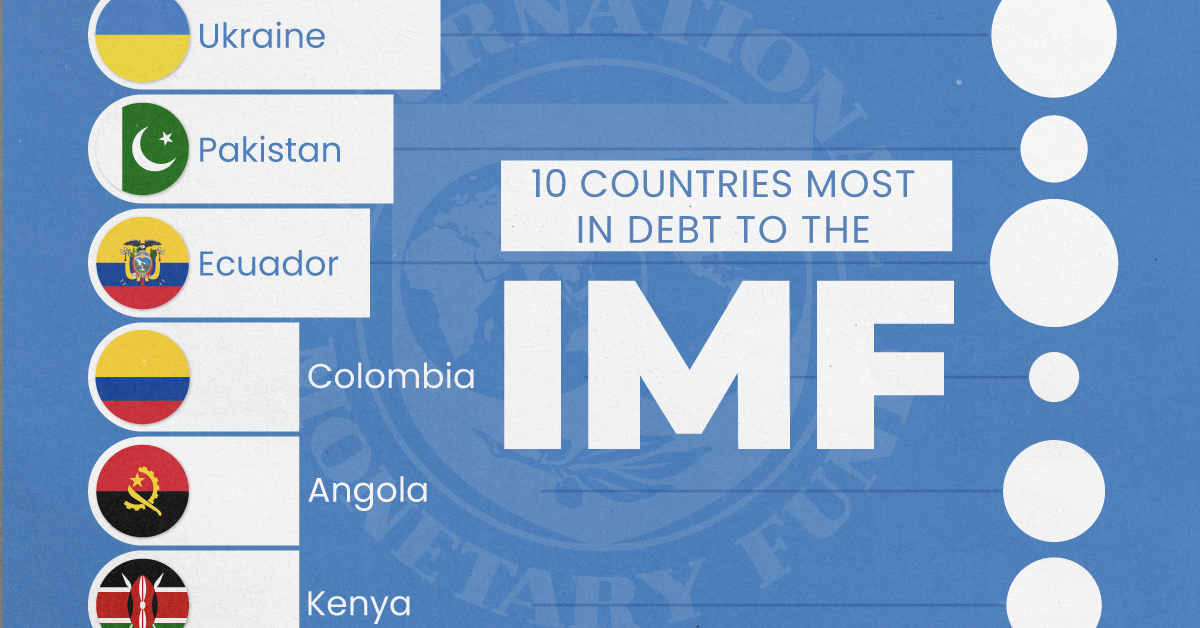
Top 10 Countries Most in Debt to the IMF
This was originally posted on our Voronoi app. Download the app for free on iOS or Android and discover incredible data-driven charts from a variety of trusted sources.
Established in 1944, the International Monetary Fund (IMF) supports countries’ economic growth by providing financial aid and guidance on policies to enhance stability, productivity, and job opportunities.
Countries seek loans from the IMF to address economic crises, stabilize their currencies, implement structural reforms, and alleviate balance of payments difficulties.
In this graphic, we visualize the 10 countries most indebted to the fund.
Methodology
We compiled this ranking using the International Monetary Fund’s data on Total IMF Credit Outstanding. We selected the latest debt data for each country, accurate as of April 29, 2024.
Argentina Tops the Rank
Argentina’s debt to the IMF is equivalent to 5.3% of the country’s GDP. In total, the country owns more than $32 billion.
| Country | IMF Credit Outstanding ($B) | GDP ($B, 2024) | IMF Debt as % of GDP |
|---|---|---|---|
| 🇦🇷 Argentina | 32 | 604.3 | 5.3 |
| 🇪🇬 Egypt | 11 | 347.6 | 3.1 |
| 🇺🇦 Ukraine | 9 | 188.9 | 4.7 |
| 🇵🇰 Pakistan | 7 | 374.7 | 1.8 |
| 🇪🇨 Ecuador | 6 | 121.6 | 4.9 |
| 🇨🇴 Colombia | 3 | 386.1 | 0.8 |
| 🇦🇴 Angola | 3 | 92.1 | 3.2 |
| 🇰🇪 Kenya | 3 | 104.0 | 2.8 |
| 🇬🇭 Ghana | 2 | 75.2 | 2.6 |
| 🇨🇮 Ivory Coast | 2 | 86.9 | 2.3 |
A G20 member and major grain exporter, the country’s history of debt trouble dates back to the late 1890s when it defaulted after contracting debts to modernize the capital, Buenos Aires. It has already been bailed out over 20 times in the last six decades by the IMF.
Five of the 10 most indebted countries are in Africa, while three are in South America.
The only European country on our list, Ukraine has relied on international support amidst the conflict with Russia. It is estimated that Russia’s full-scale invasion of the country caused the loss of a third of the country’s economy. The country owes $9 billion to the IMF.
In total, almost 100 countries owe money to the IMF, and the grand total of all of these debts is $111 billion. The above countries (top 10) account for about 69% of these debts.
-

 Technology1 week ago
Technology1 week agoCountries With the Highest Rates of Crypto Ownership
-

 Mining6 days ago
Mining6 days agoVisualizing Copper Production by Country in 2023
-

 Politics7 days ago
Politics7 days agoCharted: How Americans Feel About Federal Government Agencies
-

 Healthcare1 week ago
Healthcare1 week agoWhich Countries Have the Highest Infant Mortality Rates?
-

 Demographics1 week ago
Demographics1 week agoMapped: U.S. Immigrants by Region
-

 Economy1 week ago
Economy1 week agoMapped: Southeast Asia’s GDP Per Capita, by Country
-

 Automotive1 week ago
Automotive1 week agoHow People Get Around in America, Europe, and Asia
-

 Personal Finance1 week ago
Personal Finance1 week agoVisualizing the Tax Burden of Every U.S. State

